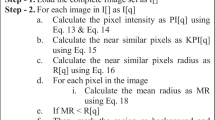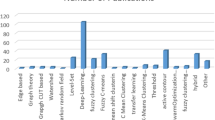Abstract
Purpose
Morphological changes to anatomy resulting from invasive surgical procedures or pathology, typically alter the surrounding vasculature. This makes it useful as a descriptor for feature-driven image registration in various clinical applications. However, registration of vasculature remains challenging, as vessels often differ in size and shape, and may even miss branches, due to surgical interventions or pathological changes. Furthermore, existing vessel registration methods are typically designed for a specific application. To address this limitation, we propose a generic vessel registration approach useful for a variety of clinical applications, involving different anatomical regions.
Methods
A probabilistic registration framework based on a hybrid mixture model, with a refinement mechanism to identify missing branches (denoted as HdMM+) during vasculature matching, is introduced. Vascular structures are represented as 6-dimensional hybrid point sets comprising spatial positions and centerline orientations, using Student’s t-distributions to model the former and Watson distributions for the latter.
Results
The proposed framework is evaluated for intraoperative brain shift compensation, and monitoring changes in pulmonary vasculature resulting from chronic lung disease. Registration accuracy is validated using both synthetic and patient data. Our results demonstrate, HdMM+ is able to reduce more than \(85\%\) of the initial error for both applications, and outperforms the state-of-the-art point-based registration methods such as coherent point drift and Student’s t-distribution mixture model, in terms of mean surface distance, modified Hausdorff distance, Dice and Jaccard scores.
Conclusion
The proposed registration framework models complex vascular structures using a hybrid representation of vessel centerlines, and accommodates intricate variations in vascular morphology. Furthermore, it is generic and flexible in its design, enabling its use in a variety of clinical applications.




Similar content being viewed by others
References
Bayer S, Maier A, Ostermeier M, Fahrig R (2017) Intraoperative imaging modalities and compensation for brain shift in tumor resection surgery. Int J Biomed Imaging 2017:6028645. https://doi.org/10.1155/2017/6028645
Bayer S, Ravikumar N, Strumia M, Tong X, Gao Y, Ostermeier M, Fahrig R, Maier AK (2018) Intraoperative brain shift compensation using a hybrid mixture model. MICCAI 2018:116–124
Bayer, S., Wydra, A., Zhong, X., Ravikumar, N., Strumia, M., Schaffert, R., Ostermeier, M., Fahrig, R., Maier, A.: An anthropomorphic deformable phantom for brain shift simulation. In: 2018 IEEE NSS/MIC conference record (2018)
Bijral, A., Breitenbach, M., Grudic, G.: Mixture of watson distributions: a generative model for hyperspherical embeddings. In: Proceedings of machine learning research (2007)
Chui H, Rangarajan A (2003) A new point matching algorithm for non-rigid registration. Comput Vis Image Underst 89(2):114–141
Dempster AP, Laird NM, Rubin DB (1977) Maximum likelihood from incomplete data via the em algorithm. J R Stat Soc Ser B Stat Methodol 39(1):1–38
Dubuisson M, Jain AK (1994) A modified hausdorff distance for object matching. In: Proceedings of 12th international conference on pattern recognition, vol. 1, pp 566–568
Estépar RSJ, Kinney GL, Black-Shinn JL, Bowler RP, Kindlmann GL, Ross JC, Kikinis R, Han MK, Come CE, Diaz AA, Cho MH, Hersh CP, Schroeder JD, Reilly JJ, Lynch DA, Crapo JD, Wells JM, Dransfield MT, Hokanson JE, Washko GR (2013) Computed tomographic measures of pulmonary vascular morphology in smokers and their clinical implications. Am J. Respir Crit Care Med 188(2):231–239
Farnia P, Ahmadian A, Khoshnevisan A, Jaberzadeh A, Serej ND, Kazerooni AF (2011) An efficient point based registration of intra-operative ultrasound images with mr images for computation of brain shift; a phantom study. IEEE EMBC 2011:8074–8077
Frangi AF, Niessen WJ, Vincken KL, Viergever MA (1998) Multiscale vessel enhancement filtering. MICCAI 1998:130–137
Gerard IJ, Kersten-Oertel M, Petrecca K, Sirhan D, Hall JA, Collins DL (2017) Brain shift in neuronavigation of brain tumors: a review. Med Image Anal 35:403–420
Lee T, Kashyap R, Chu C (1994) Building skeleton models via 3-d medial surface axis thinning algorithms. CVGIP 56(6):462–478
Liao R, Miao S, Zheng Y (2013) Automatic and efficient contrast-based 2-d/3-d fusion for trans-catheter aortic valve implantation (tavi). Comput Med Imaging Gr 37(2):150–161 Special Issue on Mixed Reality Guidance of Therapy - Towards Clinical Implementation
Luo J, Frisken SF, Machado I, Zhang M, Pieper S, Golland P, Toews M, Unadkat P, Sedghi A, Zhou H, Mehrtash A, Preiswerk F, Cheng C, Golby AJ, Sugiyama MIII,WMW (2018) Using the variogram for vector outlier screening: application to feature-based image registration. Int J Comput Assist Radiol Surg 13(12):1871–1880
Marreiros FMM, Rossitti S, Wang C, Smedby Ö (2013) Non-rigid deformation pipeline for compensation of superficial brain shift. MICCAI 2013:141–148
Matl S, Brosig R, Baust M, Navab N, Demirci S (2017) Vascular image registration techniques: a living review. Med Image Anal 35:1–17
Min Z, Meng MQ (2018) Joint alignment of multiple generalized point sets with anisotropic positional uncertainty based on expectation maximization. In: 2018 international conference on 3D vision, 3DV 2018, Verona, Italy, pp 170–179
Min Z, Wang J, Meng MQ (2018) Robust generalized point cloud registration using hybrid mixture model. ICRA 2018:4812–4818
Min Z, Wang J, Meng MQH (2018) Joint registration of multiple generalized point sets. In: Shape in Medical Imaging. Springer International Publishing, Cham, pp 169–177
Min Z, Wang J, Song S, Meng MQ (2018) Robust generalized point cloud registration with expectation maximization considering anisotropic positional uncertainties. In: 2018 IEEE/RSJ international conference on intelligent robots and systems, IROS 2018, Madrid, Spain, 2018, pp 1290–1297
Murphy K, van Ginneken B, Klein S, Staring M, de Hoop BJ, Viergever MA, Pluim JP (2011) Semi-automatic construction of reference standards for evaluation of image registration. Med Image Anal 15(1):71–84
Myronenko A, Song X (2010) Point set registration: coherent point drift. IEEE Trans Pattern Anal Mach Intell 32(12):2262–2275
Ravikumar N, Gooya A, Beltrachini L, Frangi AF, Taylor ZA (2019) Generalised coherent point drift for group-wise multi-dimensional analysis of diffusion brain mri data. Med Image Anal 53:47–63
Ravikumar N, Gooya A, Çimen S, Frangi AF, Taylor ZA (2016) A multi-resolution t-mixture model approach to robust group-wise alignment of shapes. MICCAI 2016:142–149
Ravikumar N, Gooya A, Çimen S, Frangi AF, Taylor ZA (2018) Group-wise similarity registration of point sets using student’s t-mixture model for statistical shape models. Med Image Anal 44:156–176
Ravikumar N, Gooya A, Frangi AF, Taylor ZA (2017) Generalised coherent point drift for group-wise registration of multi-dimensional point sets. MICCAI 2017:309–316
Reinertsen I, Lindseth F, Unsgaard G, Collins DL (2007) Clinical validation of vessel-based registration for correction of brain-shift. Med Image Anal 11(6):673–684
Rueckert D, Sonoda LI, Hayes C, Hill DLG, Leach MO, Hawkes DJ (1999) Nonrigid registration using free-form deformations: application to breast mr images. IEEE Trans Med Imaging 18(8):712–721
Sra S, Karp D (2013) The multivariate watson distribution: maximum-likelihood estimation and other aspects. J Multivar Anal 114:256–269
Stolk J, Putter H, Bakker EM, Shaker SB, Parr DG, Piitulainen E, Russi EW, Grebski E, Dirksen A, Stockley RA, Reiber JH, Stoel BC (2007) Progression parameters for emphysema: a clinical investigation. Respir Med 101(9):1924–1930
Zhai Z, Ota H, Staring M, Stolk J, Sugimura K, Takase K, Stoel BC (2018) Treatment effect of balloon pulmonary angioplasty in chronic thromboembolic pulmonary hypertension quantified by automatic comparative imaging in computed tomography pulmonary angiography. Invest Radiol 53(5):286–292
Zhai Z, Staring M, Ota H, Stoel BC (2018) Pulmonary vessel tree matching for quantifying changes in vascular morphology. MICCAI 2018:517–524
Zhai Z, Staring M, Stoel BC (2016) Lung vessel segmentation in CT images using graph cuts. In: Medical imaging 2016
Acknowledgements
AM and NR were supported by the Emerging Fields Initiative project BIG-THERA, ZZ is supported by China Scholarship Council scholarship No. 201406120046.
Author information
Authors and Affiliations
Corresponding author
Ethics declarations
Disclaimer
The methods and information presented in this work are based on research and are not commercially available.
Conflict of interest
The authors declare that they have no conflict of interest.
Ethical approval
The study was done retrospectively. It does not contain any studies with animals performed by any of the authors. Brain image data was acquired for clinical purposes. The SPREAD study was approved by local institute broad.
Informed consent
Informed consent was obtained from all individual participants included in the study.
Additional information
Publisher's Note
Springer Nature remains neutral with regard to jurisdictional claims in published maps and institutional affiliations.
Rights and permissions
About this article
Cite this article
Bayer, S., Zhai, Z., Strumia, M. et al. Registration of vascular structures using a hybrid mixture model. Int J CARS 14, 1507–1516 (2019). https://doi.org/10.1007/s11548-019-02007-y
Received:
Accepted:
Published:
Issue Date:
DOI: https://doi.org/10.1007/s11548-019-02007-y




